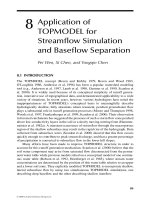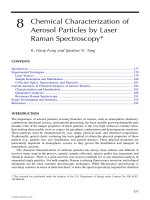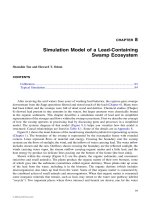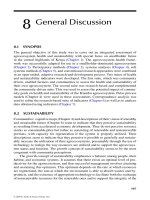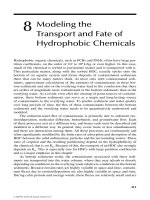Assessment in counseling chapter 8
Bạn đang xem bản rút gọn của tài liệu. Xem và tải ngay bản đầy đủ của tài liệu tại đây (137.57 KB, 16 trang )
Assessing Achievement and Aptitude: Applications for
Counseling
Chapter 8
Achievement vs. Aptitude
∗
Achievement tests: what individual has learned /acquired
∗
Aptitude tests: predict future performance /ability to learn new tasks
∗ Contrast between achievement and aptitude tests is one of purpose more than of content
Assessment of Achievement
∗
Survey achievement batteries
∗
Individual achievement tests and diagnostic achievement tests
∗
Criterion-referenced tests and minimum-level skills assessments
∗
Subject area tests
Survey Achievement Tests
∗
∗
Administered to thousands of students in multiple school districts throughout the nation
Many subtests that measure achievement in certain academic areas (i.e., reading, math,
language arts)
∗
∗
Can provide information on strengths, limitations, and the students’ progress from year to year
Often co-normed with tests of general ability or academic intelligence
Survey Achievement Tests (cont.)
∗ Examples:
∗
∗
∗
Iowa Tests
Metropolitan Achievement Tests, Eighth Edition
TerraNova, Third Edition
∗ Current, well-known achievement battery
∗ Modular series with multiple measures of achievement
∗ Achievement batteries also available for adults (i.e., Test of Adult Basic Education)
Individual Achievement Tests and
Diagnostic Achievement Tests
∗
Often used in psychoeducational evaluations (screening for learning disabilities, cognitive handicaps,
behavioral disorders, other academic issues)
∗
∗
Can also be used with adults
Commonly used achievement tests:
∗
∗
∗
Kaufman Test of Educational Achievement – Second Edition (Kaufman & Kaufman, 2004)
Wechsler Individual Achievement Test – Third Edition (Wechsler, 2009)
Wide Range Achievement Test 4 (Wilkinson & Robertson, 2007)
Individual Achievement Tests and
Diagnostic Achievement Tests (cont.)
∗ Identifying learning disabilities
∗
In the past, discrepancy model was used to identify specific learning disabilities (SLD)
∗
SLD identified when there was difference of two standard deviations between academic achievement and intellectual
ability
∗
Response to Intervention (RTI) model now replaces discrepancy model for identifying learning disabilities
∗
∗
∗
Data used to identify students at risk for poor learning outcomes
Intervention provided to student at primary, secondary or tertiary level
Student progress monitored and intervention adjusted as needed
Criterion-Referenced Tests & Minimum-Level Skills Assessments
∗
Criterion-referenced instruments:
∗
∗
Designed to determine if a certain academic standard is met
Becoming more common with increasing focus on standards and accountability in education
∗
Criterion-referenced assessments in Indiana: ISTEP+, IMAST, ISTAR
∗
Minimum-level skills tests:
∗
∗
Criterion-referenced tests where the minimum level is the “criterion” for passing
Great controversy over the institution of minimum competency examinations as prerequisite to earning high school
diploma
Subject Area Tests
∗ Single subject tests developed by teachers make up largest area of achievement tests
∗
Vary in quality, content validity should be considered
∗ Advocates of authentic assessment and performance assessment have had major
influence on teacher-developed subject area tests
Issues in Achievement Testing
∗
∗
∗
∗
Increase in standardized achievement testing in all 50 states (“high stakes testing”)
No Child Left Behind (2001)
∗
∗
Focus on educational accountability, examining individual student progress
Blueprint for revising Elementary and Secondary Education Act released in March 2010, not yet
reauthorized
National Assessment of Educational Progress (“the nation’s report card”)
AERA’s conditions for high-stakes achievement testing programs in education
Aptitude Assessment
∗
∗
Scholastic Aptitude Tests
∗
∗
∗
Scholastic Assessment Test (SAT)
American College Testing (ACT)
Graduate Record Examination (GRE)
Vocational/Career Aptitude Tests
∗
∗
∗
Armed Services Vocational Aptitude Test Battery (ASVAB)
WorkKeys
Differential Aptitude Test (DAT)
Validity of Scholastic Aptitude Tests
∗
∗
∗
Validity of SAT and ACT are about the same
∗
Correlation with freshman GPA ranges from .30 to .50
Best predictor of college success is combination of high school grades and all 3 SAT section scores
Best predictor of graduate school success is combination of GRE scores and undergraduate GPA
Vocational/Career Aptitude Tests
∗
∗
Used in career counseling to predict job or occupational performance
∗
Some used for employment selection purposes
Effective selection of instruments requires that they accurately predict successful performance of job
duties – difficult for many reasons:
∗
∗
∗
∗
Job duties within an occupation vary depending on organization and setting
What constitutes “successfully performing”?
Job performance can rarely be measured unidimensionally
Difficult to recruit large norming groups
Test Preparation and Performance
∗
∗
∗
Test sophistication – individual’s level of knowledge in test-taking skills
Coaching – training or practice on questions that are the same or similar to items on test
Education – domain or area is covered more broadly, with intent of helping test taker learn
content or information
Test Sophistication
∗
Test scores improve when individuals retake alternate form of test
∗
Individuals with extensive experience taking standardized tests have advantage
∗
Some test publishers are trying to provide free test preparation materials to create “more level
playing field”
Coaching
∗
∗
∗
∗
Research investigating effects of coaching on test results has mixed and inconsistent results
Closer the resemblance between the coaching material and test content greater improvement in
scores
“Teaching to the test” approach
General conclusions: coaching programs may increase scores slightly; significant changes occur only if
programs are longer and content is closely aligned with test material



